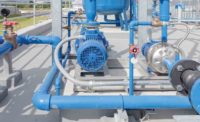This past May I wrote in the Back2Basics column about the design intent of a small city school system that chose to invest in an annual contract for a temporary air-cooled chiller for special events and emergency crisis shelter center. Now, this concept may sound foreign to many in the building industry, but this has been a niche booming business for years, so let’s discuss this.
If you peruse through your ASHRAE handbooks and try to find a chapter on how to design a temporary HVAC system for a building, you won’t have much luck. If you Google “designing a temporary HVAC building system” you will get pages of companies that furnish, install, operate, maintain, and remove temporary heating equipment/systems and also the same for air conditioning equipment/systems.
Sure, contractors provide temporary heating and/or air conditioning within a building under construction or renovation all the time, but what if a building owner, company, or community strategically chose to have temporary HVAC as part of their annual business plan? Why would anyone consider this a viable business option? Here are six reasons to have a temporary HVAC action plan.
1. No HVAC equipment first cost in the program’s construction budget
2. No equipment room space requirement in the building program’s construction budget
3. No equipment room first cost (general construction, mechanical, electrical, plumbing, or fire protection) in the building program’s construction budget
4. No annual operation and maintenance cost (e.g., specialized/licensed trade labor) in the annual operating budget
5. No annual operation and maintenance cost (e.g., parts and material inventory) in the annual operating budget
6. No end-of-useful service life replacement cost in the deferred maintenance budget
Over the years, I have been involved with a select few progressive facility managers who considered temporary HVAC equipment/systems as part of their building’s value engineering when faced with first cost and/or O&M costs. At one hospital in the northeast, the hospital had grown in square footage but expanding the central chiller plant never got into the construction budget. Right or wrong, that is what it was, and so the new facility manager asked me what his options were to accommodate peak air conditioning demand and also what to do if one of his three chillers went down.
The easy answer was to add a new chiller plant extension, but at $1,400 per ton of new chiller with associated pumps, and piping tied into the central chiller plant, this solution was not a financial option. Plan B was to consider aligning the hospital with a local chiller rental company that guaranteed delivery and startup within 24 hours if the hospital would sign an annual contract; it would also furnish and install the necessary valve and capped piping system within the hospital that terminated just outside the building in an area where the rental company could conveniently leave their two flatbed trucks (chiller and generator).
A local school department in the South included within their new middle school building program an emergency action plan where, should a disaster occur and this new school was still in operation, the building’s two-pipe heating system could be zoned to provide chilled water to the central AHUs servicing the field house. This could become a temporary community shelter with temporary cooling should the disaster occur during the summer months.
A major professional sports team had the vision to incorporate into their training field house the ability to truck in central AHUs to provide air conditioning to their practice field house for other non-sports related functions when the facility would ordinarily remain empty.
These three scenarios require design engineering in the contract document phase of the building program. Each of these scenarios also requires O&M considerations because it takes more than just hitting a switch to turn on the temporary HVAC. The changeover must be as simple as possible because the situation requires almost an immediate response once the temporary equipment arrives on site. The building can’t require a one-week start-up and commissioning of the temporary system, so the tie-in, start-up, and operation must be simple. ES




